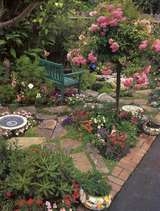“The soil is made of butterfly wings, dinosaur teeth, pumpkin seeds, lizard skins, and fallen leaves.?? Put your hands in the soil and touch yesterday, and all that will be left of tomorrow shall return?? so that new life can celebrate this day.”? -Betty Peck
Soil makes all the difference to the plants you grow. The biggest issue we gardeners face is the ongoing battle with soil. If yours is difficult to manage or just plain unproductive you?ll be disappointed like me with the performance of many of the plants you put in the ground. Even tough plants like California natives have soil preferences and they are not always what?s in your garden.

We live on ancient sea cliffs.? Soils in Bonny Doon and Scotts Valley consist of shallow, excessively drained weathered sandstone and shale. Felton soils were formed from shale, sandstone or mica schist. Those in Ben Lomond and Boulder Creek had their beginnings from weathered sandstone or granite. Although these provide the necessary mineral component of our soil. organic matter or humus from decayed plant and animal material are necessary also for fertility.
Here?s why improving your soil will make a difference to the health of your plants.
Good soil-with both organic matter and minerals-helps plants grow by forming the food supply for soil bacteria that help make food available for plant growth. Most of a plants energy goes to producing substances that drip out through the roots to attract bacteria and fungi. These in turn attract good nematodes and protozoa to the root zone. The protozoa eat bacteria and the nematodes eat not only the bacteria but also fungi and other nematodes to get carbon. What they don’t need they expel and this feeds the roots much like earthworm castings.
Down in the soil, if a plant needs different foods it can change what is secretes. Different substances will attract different bacteria, fungi, nematodes and protozoa. This huge diversity of soil biota helps the good guys keep the bad guys in check.
A common way to destroy the microbiology of the soil is to add salts in the

form or non-organic fertilizers. The salts kill the bacteria and fungi by dehydrating them. Then the plant can’t feed itself and becomes dependent on its fertilizer fix. Without the good bacteria and fungi in the soil other parts of the food chain start dying off as well.
The soil food web is also responsible for soil structure. Bacteria create slime that glue soil particles together. Fungi weave threads to create larger soil particles. Worms and insects distribute bacteria and fungal spores throughout the soil and create pathways for air and water.
What can you do to bring your soil back to life?
? Mulch around perennials, shrubs and trees with 2-3? of compost, wood chips or other organic mulch.
? Apply mycorrhizal fungi, especially in a new garden that’s been rototilled or chemically fertilized. You can find this in most organic fertilizers and some organic potting soils.
? Try to avoid walking on the root zone of plants. This kills fungi in the soil. Install stepping stones to preserve soil structure.
Feed your soil- not your plants.

.jpg?resize=300%2C269&ssl=1) over the soil by The Boy Scouts to preserve the structure and prevent it from packing down again.
over the soil by The Boy Scouts to preserve the structure and prevent it from packing down again.
